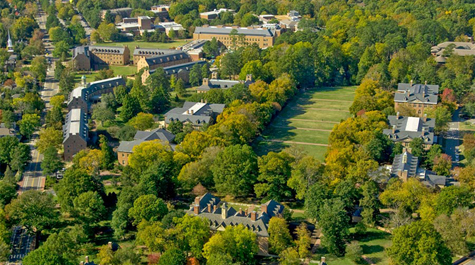W&M working group to address building names at the university
A working group of administrators, alumni, students, faculty and staff will develop principles on the naming and renaming of buildings, spaces and structures at William & Mary.
Rector John E. Littel P ’22, on behalf of the Board of Visitors, charged President Katherine A. Rowe with establishing the working group. The Board, the university’s governing body, holds ultimate responsibility for the campus landscape, including building names.
“Much progress has been made over the past decade to build a fuller and more accurate narrative of our past, led by the deep and nuanced research of the Lemon Project,” Rowe said in a memo to the Rector, outlining the working group’s charge. “More work remains to fully realize William & Mary’s values of belonging and integrity. Yet because the work to date is substantial, some near-term steps can be thoughtfully advanced.”
The country is at a key moment of national awareness, Rowe said, and developing a shared understanding of why and how we commemorate the university’s past is profoundly important.
“If any institution can approach complex questions about its institutional memory in evidence-based and nuanced ways, it is a university – and especially this university” she continued. “Because of William & Mary’s history, we have an obligation to continue the important moral and intellectual work of revisiting whom and what we commemorate. William & Mary has engaged for over a decade in sustained scholarship and forthright self-examination of the institution’s history of slavery and racism. This working group will advance how the university implements the lessons learned, now and for the future.”
The group’s charge includes the following actions:
- The group will codify principles for a) naming and renaming buildings, spaces or structures and b) developing commemorative/explanatory markers throughout campus. Rowe has asked the group to prepare a preliminary outline of such principles in a report to the president, in advance of the August Board of Visitors retreat.
- The university took action in 2015 to remove the most visible manifestations and iconography of the Confederacy from campus, including a Confederate plaque that hung in the hallway of the Wren Building and two emblems on the College Mace carried at William & Mary’s signature events. By early August, the working group will review any others and recommend actions to address, rename or contextualize them.
- Based on research by the Lemon Project and in consultation with our historically linked Indigenous communities, the working group will prepare a prioritized list of appropriate new names for any buildings the Board may wish to name as they come online for consideration.
- The working group will conduct a comprehensive landscape review to identify additional structures that may be perceived as barriers to a welcoming and inclusive environment. A final report is due to the president by the February 2021 Board meeting.
- Jody L. Allen Ph.D. ’07, director of the Lemon Project and assistant professor of history
- Sara Bon-Harper Ph.D., executive director of James Monroe’s Highland
- Howard J. Busbee ’65, J.D. ’67, M.L.T. ’68, clinical professor emeritus of business and former member of the Alumni Association Board of Directors
- Davison M. Douglas Ph.D., law professor and outgoing dean of the W&M Law School
- Chief Diversity Officer Chon Glover M.Ed. ’99, Ed.D. ’06
- Student Assembly President Anthony M. Joseph ’21
- Susan Kern Ph.D. ’05, executive director of the Historic Campus
- Milka D. Mered ’20, winner of the Sullivan Award for service to the university
- Danielle Moretti-Langholtz Ph.D., director of the American Indian Resource Center and curator for the Native American Art at W&M’s Muscarelle Museum of Art
- Williamsburg City Council Member Caleb Rogers ’20
- Jay T. Watkins III Ph.D., visiting assistant professor of history, with expertise in monuments and commemoration
- Jessica L. Walton, deputy secretary to the Board, will staff the group















